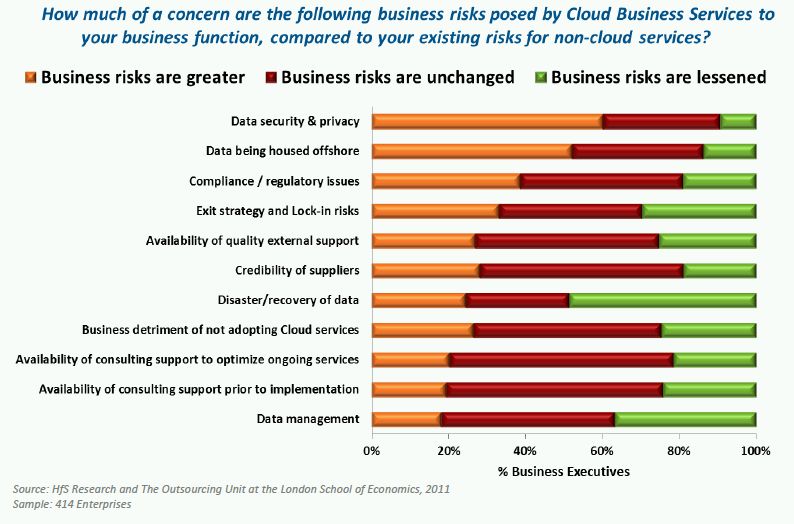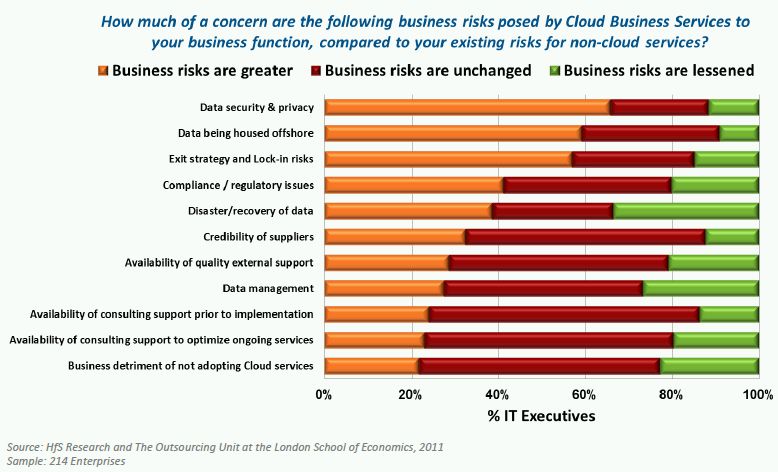Executive Summary
Cloud Computing is refashioning the cost, quality, speed and flexibility by which businesses can access—and suppliers can deliver—services to support business needs. As Cloud-based services mature, many business functions can reduce their reliance on on-premises software, hardware and internal administration to access many Cloud services.
Cloud Computing has developed from a modular point solution in the form of SaaS deployments (e.g., talent management and expense management) to become an increasingly integral method for leveraging computing resources for IT and business. The rapid adoption of Cloud alternatives by the business has meant that management disciplines, standards and best practices are well behind where most organizations need them to be, in order to manage appropriately both IT and business risks.
This disruptive change that is challenging today's organizations to take advantage of Cloud-based services, is proving a difficult pill to swallow for many organizations. They need support and advice to help them with both internal IT and business process transformation, in addition to the contractual advice to ensure they are approaching their Cloud opportunities in the right way to mitigate risk and maximize productivity advantages.
This report provides both IT and Business executives with a detailed assessment of Cloud adoption strategies, an analysis of business benefits, concerns, challenges and contractual issues that need to be addressed and discusses the key services providers in the market.
1. Defining the Cloud
The Cloud is proving to be the most misunderstood technological advance to impact business in the last decade but for those that can harness and manage its potential it may prove an enabling technology that could radically alter the face of business.
During a recent survey conducted by HfS Research and the Outsourcing Unit of the London School of Economics, over 60% of Business Executives and almost 70% of IT Executives offered a definition of the Cloud as an "enabling business services/IT delivery model that drives innovation in organizations"—while succinct, this does not clearly define it for what it is, rather what its potential is.
Wikipedia's definition of the Cloud focuses on the technical architecture and its ability for anyone, anywhere, to access any resources available with limited or no software required (see sidebar). It concludes by saying
"The principle behind the Cloud is that any computer connected to the internet is connected to the same pool of computing power, applications, and files."
This is the most telling aspect of what Cloud Computing can do for organizations—it opens up the world, to the world, creating new businesses, revenue streams and models that we believe will launch a new, more rapid phase of global innovation.
Differentiating between Cloud, Hosting, and Outsourcing
At a practical level Cloud, hosting and outsourcing can all be categorized within the context of a third-party providing some level of function/expertise as a service.
Outsourcing may carry a more complete value proposition involving taking entire servers, middleware, and other systems and managing them for your organization in a different location. Leveraging the services provider's economies of scale, the outsourcing provider can provide you with cheaper operations than it would take for your organization to achieve the same level of service.
From a delivery perspective we see a continuum of Cloud models from unique private Cloud offerings for a business served up in a one-to-one model, to public solutions where a client subscribes to services from a services provider in a one-to- few or many model, to emerging community solutions that bring together both buyers and sellers in the form of a many-to-many model such as the Ariba Network.
Essentially Cloud and hosting can be considered different flavors of outsourcing. Hosted solutions are typically crafted in a one-to-one model rather than a Cloud-based one-to-many model. Deep level integration with other applications or systems may require extensive coding. Not only must the integration be built, but also security layers must also be built for that specific implementation. Further, any changes to the security or integration layers may require a lengthy testing process to ensure that they still work. This complexity is what leads hosted solutions to be considered as relatively standalone. The Cloud through leveraging multi-tenancy, or the ability to provide multiple users' customized access to a single scalable solution not only reduces the number of hardware resources but also allows for far more powerful, distributed access to them.
The Reality versus the Hype
The reality of the Cloud today is that it is a nascent set of technologies and services that is seeing fast adoption in the market but the market itself is in danger of boiling over in terms of inflated expectations. HfS wants to calm some fears as our recent survey conducted with The Outsourcing Unit of the London School of Economics highlighted that both IT and business executives do maintain concerns about adopting the Cloud (see Exhibit 1 and 2) and are planning accordingly. Business executives are concerned about the location of their data, their secure access to it, but are less concerned about the underlying technology.
Exhibit 1 Business executives need reassurance

One item that deserves to be highlighted from the survey relates to compliance and legal implications. These grow considerably when dealing with implementations across different countries and industry verticals. We expect regulatory compliance, security and privacy issues to become even more important buying criteria as Cloud adoption continues and the fact that both IT and Business executives share the same Cloud concerns (see Exhibit 2). Don't give in to the temptations of "going Cloud" without a program in place that clearly defines what value it provides, how it will de-risk your business and how you will manage new risks over time. Ensure that you have a handle of the realities of Cloud architectures, providers' capabilities and the business solutions they target to prevent you or your business from being swept up by hype.
Exhibit 2 IT executives have same concern as business executives over security and offshore

Benefits and Drawbacks of Cloud Adoption
The benefits of Cloud Computing are being more clearly understood as we see adoption in the marketplace and they are being realized within the majority of organizations. According to our research, there are three clear benefits to Cloud Computing:
- Scalability. Being able to improve performance at any time by simply adding resources is something that most CIOs and IT workers dream about. Providers like Rackspace and Amazon are moving to make this a service reality with the development of relatively elastic compute grids. For many organizations the services availability and assurance available from Cloud providers are far better than can be provisioned internally. Organizations have to test how to better scale up and down services over time, and this will require investment in people with requisite skills and new technologies to help with planning and migrating applications to the Cloud.
- Availability. IT Organizations traditionally have spent lots of money, time, and resources in preparing backup and disaster-recovery locations and sites. Testing, drills, and dry runs all increase the management cost. Cloud Computing simplifies the process by providing these functions as part of the bundled service.
- Integration. As world economies continue to merge, organizations are becoming increasingly entwined with partners, suppliers, and customers. As such computing standards need to be developed to effectively improve communication. A universal layer to which all adhere (using SOA and service calls to platforms and leveraging integration points via infrastructure) reduces some of the complexity of integration. Cloud vendors and providers that emphasize their own Cloud model over an open Cloud should be asked to support open standards and interconnectivity, or new alliances should be sought.
There are certain drawbacks to leveraging Cloud Computing in relation to on-premises alternatives or maintaining the status quo, especially at this stage of evolution. Early adopters of Cloud Computing have experienced issues related to:
- Architecture. Organizations may need to change their architecture to adopt the Cloud and this is no small matter for some. At the very least, making other systems and applications aware of the remote infrastructure and platform, and at the extreme end—moving the entire internal architecture to a Cloud model. In either case, it takes time, planning, careful execution, and plenty of testing. Issues from latency to security can cause deployment problems that can be spotted and dealt with through thorough analysis and testing.
- Education. Hype about the Cloud is everywhere. Separating technology hype from business reality is a big challenge. Organizations need to educate the business and IT workforce as to what is realistic and what's not. Invest in proper education and reap the rewards of not following the hype. The IT organization has the opportunity to cement its relationships as trusted advisors for business executives that struggle with Cloud and it implications to the business.
- Offering Maturity. The Cloud community's wake-up call came when Amazon's EC2 infrastructure crashed in April 2011. Part of IT and the industry's development is going to be learning how to make solutions more available, stable and mature and how organizations should plan for and respond to this type of risk.
To read the remainder of this article please click here.
The content of this article is intended to provide a general guide to the subject matter. Specialist advice should be sought about your specific circumstances.

